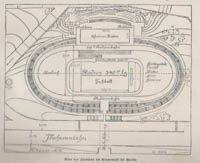Deutsches Stadion – until 1934
| Capacity | 33 000 |
|---|---|
| Country | Germany |
| City | Berlin |
| Clubs | - |
| Retire year | 1934 |
| Inauguration | 08/06/1913 |
| Construction | 08/1912 – 05/1913 |
| Cost | DM 2.25 M |
| Record attendance | 64,000 (Hamburger SV – SC Union Oberschöneweide 3–0, 10/06/1923) |
| Design | Otto March |
Advertisement
Deutsches Stadion – historical stadium description
How is the former Deutsches Stadion characterized in brief?
On the site of the current Olympic Stadium in Berlin, there used to be the so-called Deutsches Stadion, built in 1912–1913 for the 1916 Olympic Games, which were to be held in the German capital. The Games were eventually canceled due to the ongoing World War I.
After the war, however, Deutsches Stadion played an important role and was tried on as the main venue for the next Games to be held in Berlin, this time in 1936. Those plans changed and the decision was made to demolish it and build a completely new, massive Olympic Stadium in its place.
The former Deutsches Stadion was unique in one respect: it was a truly multi-purpose venue. The facility had an athletics track, which was surrounded by a cycling track, and there was still a swimming pool integrated into the whole. In addition, the stadium was located inside the horse racing track, and the main entrance to the stadium was through a tunnel, which still survives today.
What is the history of Deutsches Stadion?
How did the Deutsches Stadion come to be?
At the turn of the 20th century, equestrianism was a popular sport in Germany, especially among the aristocracy. In February 1907, Berlin's leading equestrian club, the Union-Klub, leased a plot of land in the northern part of the Grunewald Forest, in the western suburbs of the German capital, which were becoming an increasingly popular migration point among wealthier Berliners.
A new horse racing track was to be built on the leased plot of land. However, the area was intended as a place for recreation and sports for all residents, so the construction of a multi-purpose stadium was a condition for the creation of the racetrack. Great credit for the creation of the new sports facilities went to Victor von Podbielski.
Plans for the track were created by architect Otto March. The design called for the construction of a new stadium inside the Hippodrome, and access to the stadium was to be through a tunnel. However, the horse racing track, known as Rennbahn Grunewald, was realized first, and was inaugurated on May 23, 1909.
When was Deutsches Stadion built?
The impetus for the second part of the project, the stadium, was the awarding of the 1916 Olympics to Berlin in 1912. Construction work began in August 1912. The new stadium was to be largely dug into the ground so as not to interfere with views of the horse races – this was done using the natural basin that was inside the racecourse.
When was Deutsches Stadion opened?
Work proceeded smoothly and was completed in May 1913, with the cost of building the facility at 2.25 million marks. The inauguration took place on June 8, 1913, on the occasion of celebrations marking the 25th anniversary of Wilhelm II's seizure of the throne.
The opening of Deutsches Stadion in Berlin was not lived to see its architect, Otto March, who died on April 1, 1913 – the courtyard in front of the entrance to the tunnel leading to the stadium was named in his honor ("Marchhof").
What was the name given to the stadium inside the Grunewald racecourse?
The facility was named Deutsches Stadion (German Stadium, National Stadium), although it was also called Grunewaldstadion.
It is worth mentioning that the name Deutsches Stadion is also held by the unfinished giant stadium at the NSDAP convention grounds in Nuremberg. The stadium had been under construction since 1937, but work was interrupted by the outbreak of World War II. According to the plans, the facility was to hold up to 400,000 spectators, which would have made it unquestionably the largest of its kind in the world.
What did Deutsches Stadion look like?
The new stadium was truly multifunctional: the field was surrounded by a 600-meter athletics track, which in turn was encircled by a contoured 666-meter-long cycling track. In addition, an outdoor 100-meter swimming pool was integrated into the facility, which was located on the north side.
The entire facility was surrounded by stands with 11,500 seats and 18,500-capacity standing room. The stand next to the pool could accommodate another 3,000 people, giving a total capacity of 33,000 spectators. Except for the emperor's lodge, the auditorium had no canopy.
The main stand with the emperor's lodge was located on the south side and was accessed by a tunnel running under the racetrack. The north stand, located next to the pool, was slightly set back and flanked by colonnaded buildings. It was decorated with various sculptures, led by a tall, centrally placed column with a goddess of victory.
What was the Podbielski Oak?
The stadium was built on a former forest area, one remnant of which was an oak tree standing at the edge of the eastern curve of the stands. The tree was incorporated into the facility, enclosed with a special platform and named in honor of Victor von Podbielski (Podbielski Oak – Podbielski-Eiche), meritorious for the construction of the stadium, as well as for the award of the 1916 Olympics to Berlin.
On February 26, 1914, Podbielski's 70th birthday was celebrated at the stadium, and on the occasion a bronze plaque bearing his image was unveiled and placed under the oak tree.
What was the fate of Deutsches Stadion?
After the outbreak of World War I, the stadium was closed, and in 1915 it was turned into a field hospital. In 1916 it was restored as a sports facility. The ongoing war, however, caused the Olympic Games scheduled for 1916 to be canceled.
The facility was built in the western suburbs of Berlin, west of Charlottenburg, which was still a separate city at the time. The stadium did not become incorporated into Berlin's administrative boundaries until October 1, 1920, following the introduction of the Greater Berlin Act.
After the war ended, the stadium served as one of the country's leading sports facilities. In 1922, 1923, 1924 and 1927 it hosted the finals of the German football championship, and six friendly matches were also played here by the German national team, including the first home match after the end of World War I (a 1-0 win against Hungary on October 24, 1920 – interestingly, this was the only German victory at this venue).
On May 24, 1926, Finnish athlete Paavo Nurmi set a world record in the 3000-meter run at Deutsches Stadion with a time of 8:25.4. In addition to sports competitions, the stadium also hosted other events, such as political rallies and the celebration of the 80th birthday of then German President Paul von Hindenburg (October 2, 1927).
The number of spectators sometimes exceeded the nominal 33,000. Fans gathered on the cycling track, the sculptures and even the roof of the imperial lodge. The attendance record was set on June 10, 1923, when the German football championship final between Hamburger SV and local SC Union Oberschöneweide (3–0) was played at the stadium – the game was watched by 64,000 spectators.
Why was Deutsches Stadion demolished?
In 1931 Berlin was awarded the organization of the Olympic Games, which were to be held in 1936. Initially it was planned that the main venue for these event would be the multi-purpose Deutsches Stadion, which was built for the games to be held 20 years earlier. Before the second attempt, plans were made to expand it, and one of the designs called for moving the swimming pool behind the stadium's western curve.
The expansion plans were abandoned after the Nazis came to power in 1933, who saw an opportunity to use the Games as a propaganda tool and decided to ensure the grandeur of the event. The new Reich Chancellor, Adolf Hitler, recommended the demolition of the old stadium and the construction of a completely new, monumental Olympic Stadium. Its design was prepared by Werner March, son of Otto March, who had designed Deutsches Stadion.
When was the Deutsches Stadion demolished?
The old stadium was demolished in 1934, and with it also the surrounding horse racing track, making room for the creation of an entire sports complex, named Reichssportfeld (now Olympiapark). All that remained of the old stadium was the tunnel leading to it, which was incorporated into the new facility.
Even the Podbielski Oak has been removed, although the same name was given to another oak tree, which stands at the main entrance to the Olympic Stadium grounds (on the eastern side). A bronze commemorative plaque with Podbielski's image, which was placed under the oak, is now on the wall of the Marathon Gate of the new stadium.
When was the new Olympic Stadium in Berlin opened?
Construction of the new stadium lasted until the summer of 1936. The facility was built largely on the site of its predecessor, with a slight shift to the northeast. The huge new Olympic Stadium could accommodate up to 100,000 spectators, and was inaugurated with the opening ceremony of the 1936 Olympic Games, which took place on August 1.
Advertisement
Pictures
1932
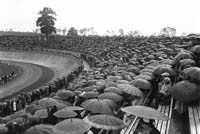
1932 © Georg Pahl / Bundesarchiv
1929
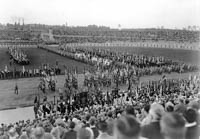
1929 © Georg Pahl / Bundesarchiv 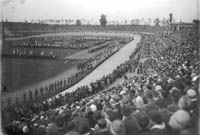
1929 © Georg Pahl / Bundesarchiv
1928
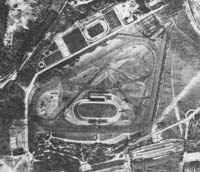
1928 © Land Berlin
1924
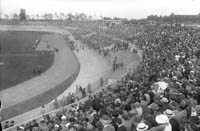
08.06.1924 © Georg Pahl / Bundesarchiv
1913
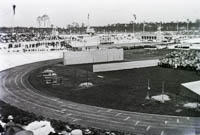
08.06.1913 © Schmidt Albin / Fortepan 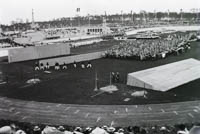
08.06.1913 © Schmidt Albin / Fortepan 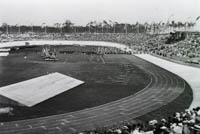
08.06.1913 © Schmidt Albin / Fortepan 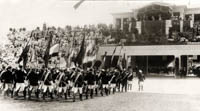
08.06.1913 © Spaarnestad Photo 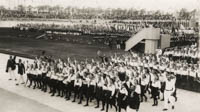
08.06.1913 © Spaarnestad Photo

 StadiumDB
StadiumDB